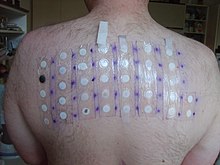Nickel(II) sulfate
| |||

| |||
| Names | |||
|---|---|---|---|
| IUPAC name
Nickel(II) sulfate
| |||
| Other names
Nickelous sulfate
| |||
| Identifiers | |||
| |||
3D model (JSmol)
|
|||
| ChEBI | |||
| ChemSpider | |||
| ECHA InfoCard | 100.029.186 | ||
| EC Number |
| ||
PubChem CID
|
|||
| RTECS number |
| ||
| UNII | |||
CompTox Dashboard (EPA)
|
|||
| |||
| |||
| Properties | |||
| NiSO4 | |||
| Molar mass | 154.75 g/mol (anhydrous) 262.85 g/mol (hexahydrate) 280.86 g/mol (heptahydrate) | ||
| Appearance | yellow solid (anhydrous) blue crystals (hexahydrate) green-blue crystals (heptahydrate) | ||
| Odor | odorless | ||
| Density | 4.01 g/cm3 (anhydrous) 2.07 g/cm3 (hexahydrate) 1.948 g/cm3 (heptahydrate) | ||
| Melting point | > 100 °C (anhydrous) 53 °C (hexahydrate) | ||
| Boiling point | 840 °C (1,540 °F; 1,110 K) (anhydrous, decomposes) 100 °C (hexahydrate, decomposes) | ||
| 65 g/100 mL (20 °C) 77.5 g/100 mL (30 °C) (heptahydrate) | |||
| Solubility | anhydrous insoluble in ethanol, ether, acetone hexahydrate very soluble in ethanol, ammonia heptahydrate soluble in alcohol | ||
| Acidity (pKa) | 4.5 (hexahydrate) | ||
Refractive index (nD)
|
1.511 (hexahydrate) 1.467 (heptahydrate) | ||
| Structure | |||
| cubic (anhydrous) tetragonal (hexahydrate) rhombohedral (hexahydrate) | |||
| Hazards | |||
| NFPA 704 (fire diamond) | |||
| Flash point | Non-flammable | ||
| Lethal dose or concentration (LD, LC): | |||
LD50 (median dose)
|
264 mg/kg | ||
| Related compounds | |||
Other cations
|
Cobalt(II) sulfate Copper(II) sulfate Iron(II) sulfate | ||
Except where otherwise noted, data are given for materials in their standard state (at 25 °C [77 °F], 100 kPa).
| |||
Nickel(II) sulfate, or just nickel sulfate, usually refers to the inorganic compound with the formula NiSO4(H2O)6. This highly soluble blue-coloured salt is a common source of the Ni2+ ion for electroplating.
Approximately 40,000 tonnes were produced in 2005. It is mainly used for electroplating of nickel.[1]
In 2005–06, nickel sulfate was the top allergen in patch tests (19.0%).[2]
Structures
At least seven sulfate salts of nickel(II) are known. These salts differ in terms of their hydration or crystal habit.
The common tetragonal hexahydrate crystallizes from aqueous solution between 30.7 and 53.8 °C. Below these temperatures, a heptahydrate crystallises, and above these temperatures an orthorhombic hexahydrate forms. The yellow anhydrous form, NiSO4, is a high melting solid that is rarely encountered in the laboratory. This material is produced by heating the hydrates above 330 °C. It decomposes at still higher temperatures to nickel oxide.[1]
X-ray crystallography measurements show that NiSO4·6H2O consists of the octahedral [Ni(H2O)6]2+ ions. These ions in turn are hydrogen bonded to sulfate ions.[3] Dissolution of the salt in water gives solutions containing the aquo complex [Ni(H2O)6]2+.
All nickel sulfates are paramagnetic.
Production, applications, and coordination chemistry
The salt is usually obtained as a by-product of copper refining. It is also produced by dissolution of nickel metal or nickel oxides in sulfuric acid.
Aqueous solutions of nickel sulfate reacts with sodium carbonate to precipitate nickel carbonate, a precursor to nickel-based catalysts and pigments.[4] Addition of ammonium sulfate to concentrated aqueous solutions of nickel sulfate precipitates Ni(NH4)2(SO4)2·6H2O. This blue-coloured solid is analogous to Mohr's salt, Fe(NH4)2(SO4)2·6H2O.[1]
Nickel sulfate is used in the laboratory. Columns used in polyhistidine-tagging, useful in biochemistry and molecular biology, are regenerated with nickel sulfate. Aqueous solutions of NiSO4·6H2O and related hydrates react with ammonia to give [Ni(NH3)6]SO4 and with ethylenediamine to give [Ni(H2NCH2CH2NH2)3]SO4. The latter is occasionally used as a calibrant for magnetic susceptibility measurements because it has no tendency to hydrate.
Natural occurrence
Nickel sulfate occurs as the rare mineral retgersite, which is a hexahydrate. The second hexahydrate is known as nickelhexahydrite(Ni,Mg,Fe)SO4·6H2O. The heptahydrate, which is relatively unstable in air, occurs as morenosite. The monohydrate occurs as very rare mineral dwornikite (Ni,Fe)SO4·H2O.
Safety

In 2005–06, nickel sulfate was the top allergen in patch tests (19.0%).[2]
Nickel salts are carcinogenic and irritate the skin.
References
- ^ a b c K. Lascelles, L. G. Morgan, D. Nicholls, D. Beyersmann “Nickel Compounds” in Ullmann's Encyclopedia of Industrial Chemistry, Wiley-VCH, Weinheim, 2005. Vol. A17 p. 235 doi:10.1002/14356007.a17_235.pub2.
- ^ a b Zug KA, Warshaw EM, Fowler JF Jr, Maibach HI, Belsito DL, Pratt MD, Sasseville D, Storrs FJ, Taylor JS, Mathias CG, Deleo VA, Rietschel RL, Marks J. Patch-test results of the North American Contact Dermatitis Group 2005–2006. Dermatitis. 2009 May–Jun;20(3):149-60.
- ^ Wells, A. F. (1984). Structural Inorganic Chemistry, Oxford: Clarendon Press. ISBN 0-19-855370-6.
- ^ H. B. W. Patterson, "Catalysts" in Hydrogenation of Fats and Oils G. R. List and J. W. King, Eds., 1994, AOCS Press, Urbana.



